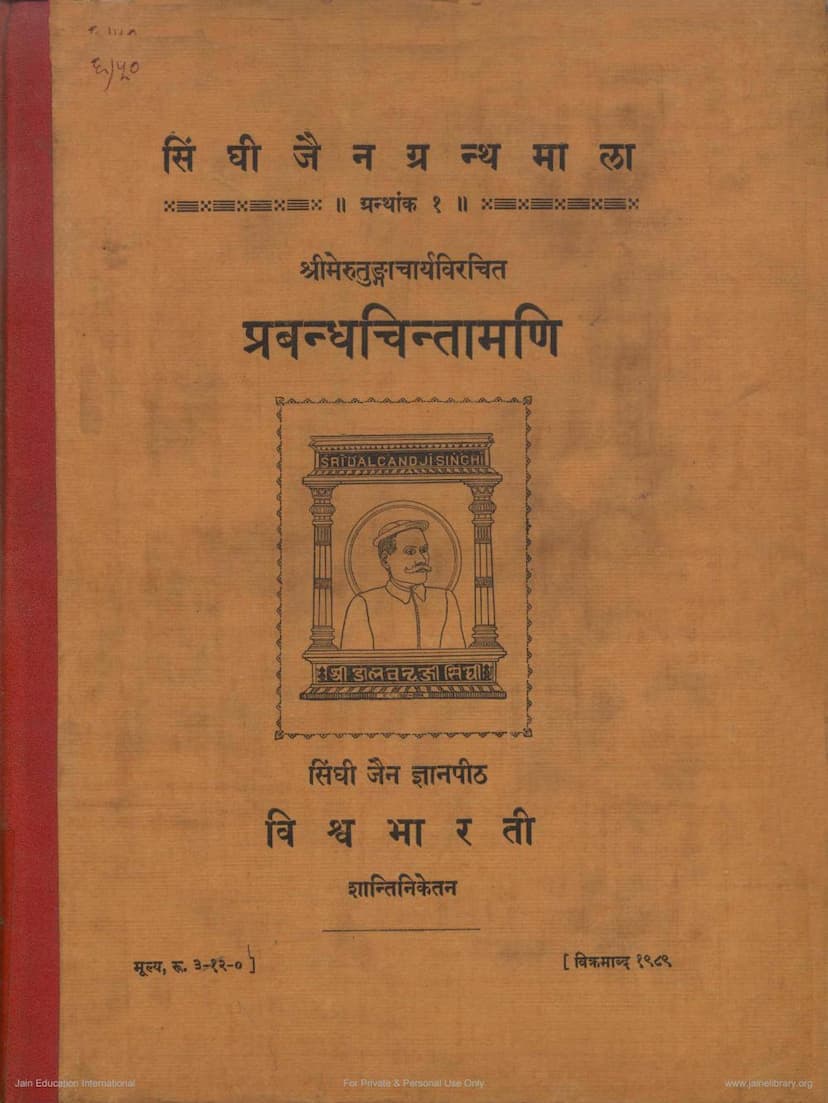Prabandha Chintamani
Added to library: September 2, 2025

Summary
The "Prabandha Chintamani" (प्रबन्धचिन्तामणि), authored by Merutungacharya and edited by Jinavijaya Muni, is a significant Jain text published by the Singhi Jaina Granthamala series. This comprehensive summary, based on the provided pages, aims to capture the essence and scope of this work.
Overview of the Publication:
The "Prabandha Chintamani" is presented as the first publication in the Singhi Jaina Granthamala series, founded by Shri Bahadur Singhji Singhi in memory of his father, Shri Dalchandji Singhi. The series aims to publish important canonical, philosophical, historical, literary, and narrative works of Jain literature in Prakrit, Sanskrit, Apabhramsa, and Old Vernacular languages, along with scholarly studies. The General Editor is Jinavijaya Muni, and the publication is overseen by the Adhishthata of Singhi Jaina Jnanapitha at Santiniketan.
The specific edition of "Prabandha Chintamani" being summarized is critically edited in the original Sanskrit with variants. It includes:
- The original Sanskrit text: Based on various ancient manuscripts.
- Supplements of similar Prabandhas: Related or analogous historical narratives.
- Corresponding epigraphical records and references: Inscriptions, copper plates, colophons, and citations from other works that corroborate the text.
- Hindi translation and notes: To aid in understanding the content.
- Elaborate, critical, and historical introduction: Providing context and analysis.
The work is planned to be completed in five parts:
- Part I: Critical edition of the original Sanskrit text with variants, an appendix, and an alphabetical index of verses.
- Part II: Collection of old Prabandhas similar to those in the Prabandha Chintamani, with indices of verses and proper names.
- Part III: Complete Hindi translation of Parts I and II.
- Part IV: Collection of epigraphical records and historical data related to the persons described in the Prabandha Chintamani, with a critical Hindi account and plates.
- Part V: An elaborate general introduction surveying the historical, geographical, social, political, and religious conditions of the period, with illustrations.
The first edition, with a print run of one thousand copies, was published in V.E. 1989 (1933 AD) / 1933 AD.
Author and Editor:
- Author: Merutungacharya (श्रीमेरुतुङ्गाचार्य)
- Editor/Compiler: Jinavijaya Muni (जिनविजय मुनि), who is also the Adhishthata of Singhi Jaina Jnanapitha and Singhi Professor of Jaina Culture at Visvabharati.
Historical Context and Purpose:
The introduction (किंचित् प्रास्ताविक) highlights the critical need to bring to light historically significant Jain texts languishing in Jain Bhandars. The editor, Jinavijaya Muni, was inspired by the guidance of Param Pujya Pravartak Shrimat Kantivijayji Maharaj and his disciples to undertake this research. The initiative was further supported by philanthropic efforts, particularly by the Singhi family, who established the Singhi Jide Jnanapith at Santiniketan. The work aims to provide a critical and historically contextualized edition of the Prabandha Chintamani, making it accessible to scholars and the public.
Content and Structure (as per the Table of Contents):
The "Prabandha Chintamani" is structured into five "Prakashas" (parts or sections), each focusing on a particular set of historical figures or events, primarily kings and prominent personalities associated with Jainism. The extensive table of contents reveals a vast collection of narratives covering:
- First Prakash: Narratives related to Vikramarka (Vikramaditya), detailing his reign, achievements, and various anecdotes. This section includes stories about his lineage, encounters with scholars like Kalidasa, acquisition of treasures, and his interactions with supernatural beings. It also mentions the tales of Satavahana, Shulavata Bhuyaraja, and Vanaraja, founders of the Chalukya dynasty.
- Second Prakash: Focuses on Bhoja and Bhima and their historical accounts, including their conflicts and donations.
- Third Prakash: Deals with Siddharaja and subsequent rulers, including Mulraja, Munja, Bhoja, and Siddharaja himself. This section is extensive and covers their lives, administration, wars, religious policies, and interactions with Jain scholars like Hemachandrasuri.
- Fourth Prakash: Centers on Kumarapala and his successors, including the narratives of Vastupala and Tejapala. This part highlights Kumarapala's conversion to Jainism, his patronage of Jainism, and the significant architectural and religious contributions made during his reign.
- Fifth Prakash: Contains miscellaneous or Prakirnaka Prabandhas, covering a diverse range of historical figures, poets, scholars, and incidents that don't fit neatly into the previous chronological categories. It includes accounts of figures like Nanda, Mallavadi, Shiladitya, Varamihira, Nagarjuna, and Bhartrihari.
Key Features Highlighted in the Introduction:
- Critical Edition: The emphasis is on providing a textually accurate edition based on a comparison of multiple ancient manuscripts.
- Scholarly Apparatus: The inclusion of variant readings, Hindi translation, notes, and an extensive historical introduction demonstrates a commitment to scholarly rigor.
- Historical Significance: The work is recognized for its immense value in reconstructing the history of Jainism, Indian rulers, social customs, and religious practices of the medieval period.
- Founders' Vision: The publication reflects the philanthropic vision of the Singhi family in promoting Jain knowledge and literature.
Manuscript Usage:
The introduction details the critical approach taken in editing the text, specifying the manuscripts used (labeled A, B, P, Po, D, etc.) and their origins (e.g., Delaka Upashraya in Ahmedabad, Sagar Gachha Upashraya in Patan, Bhandarkar Oriental Research Institute in Pune). The editor discusses the process of collating variants and the challenges posed by different readings and the condition of the manuscripts.
Overall, the "Prabandha Chintamani" as published by the Singhi Jaina Granthamala is presented as a monumental scholarly endeavor, aimed at preserving and disseminating a crucial piece of Jain historical and literary heritage. It underscores the dedication to making this ancient text accessible and understandable through critical editing, translation, and detailed historical context.